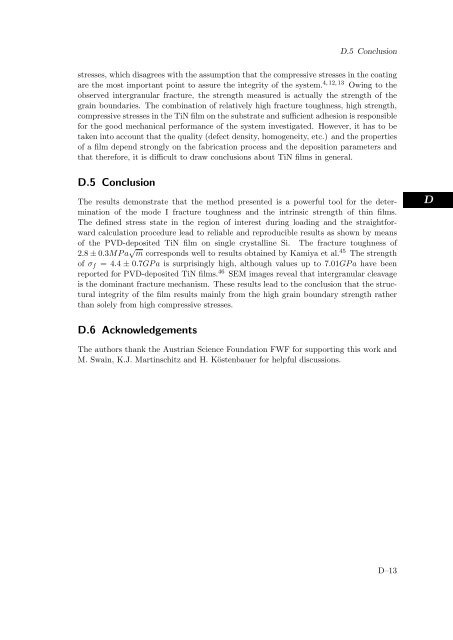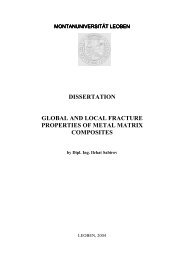1 - Erich Schmid Institute
1 - Erich Schmid Institute
1 - Erich Schmid Institute
You also want an ePaper? Increase the reach of your titles
YUMPU automatically turns print PDFs into web optimized ePapers that Google loves.
D.5 Conclusion<br />
stresses, which disagrees with the assumption that the compressive stresses in the coating<br />
are the most important point to assure the integrity of the system. 4, 12, 13 Owing to the<br />
observed intergranular fracture, the strength measured is actually the strength of the<br />
grain boundaries. The combination of relatively high fracture toughness, high strength,<br />
compressive stresses in the TiN film on the substrate and sufficient adhesion is responsible<br />
for the good mechanical performance of the system investigated. However, it has to be<br />
taken into account that the quality (defect density, homogeneity, etc.) and the properties<br />
of a film depend strongly on the fabrication process and the deposition parameters and<br />
that therefore, it is difficult to draw conclusions about TiN films in general.<br />
D.5 Conclusion<br />
The results demonstrate that the method presented is a powerful tool for the determination<br />
of the mode I fracture toughness and the intrinsic strength of thin films.<br />
The defined stress state in the region of interest during loading and the straightforward<br />
calculation procedure lead to reliable and reproducible results as shown by means<br />
of the PVD-deposited TiN film on single crystalline Si. The fracture toughness of<br />
2.8 ± 0.3MP a √ m corresponds well to results obtained by Kamiya et al. 45 The strength<br />
of σf = 4.4 ± 0.7GP a is surprisingly high, although values up to 7.01GP a have been<br />
reported for PVD-deposited TiN films. 46 SEM images reveal that intergranular cleavage<br />
is the dominant fracture mechanism. These results lead to the conclusion that the structural<br />
integrity of the film results mainly from the high grain boundary strength rather<br />
than solely from high compressive stresses.<br />
D.6 Acknowledgements<br />
The authors thank the Austrian Science Foundation FWF for supporting this work and<br />
M. Swain, K.J. Martinschitz and H. Köstenbauer for helpful discussions.<br />
D–13<br />
D
















